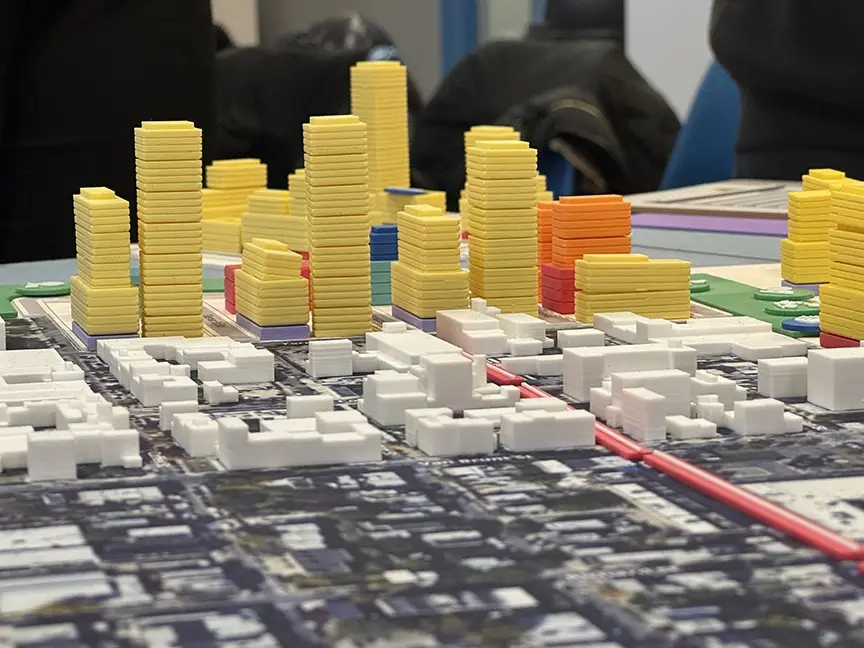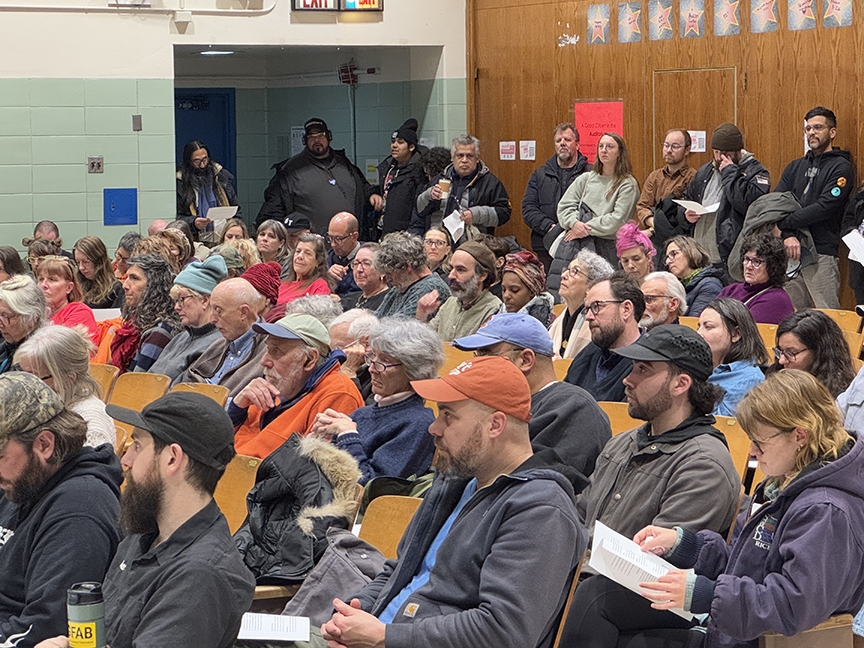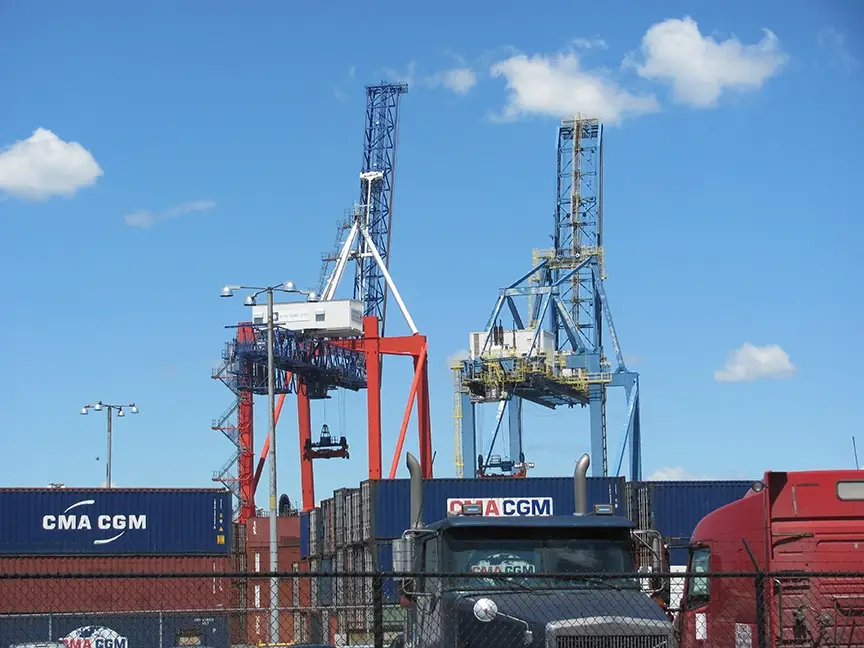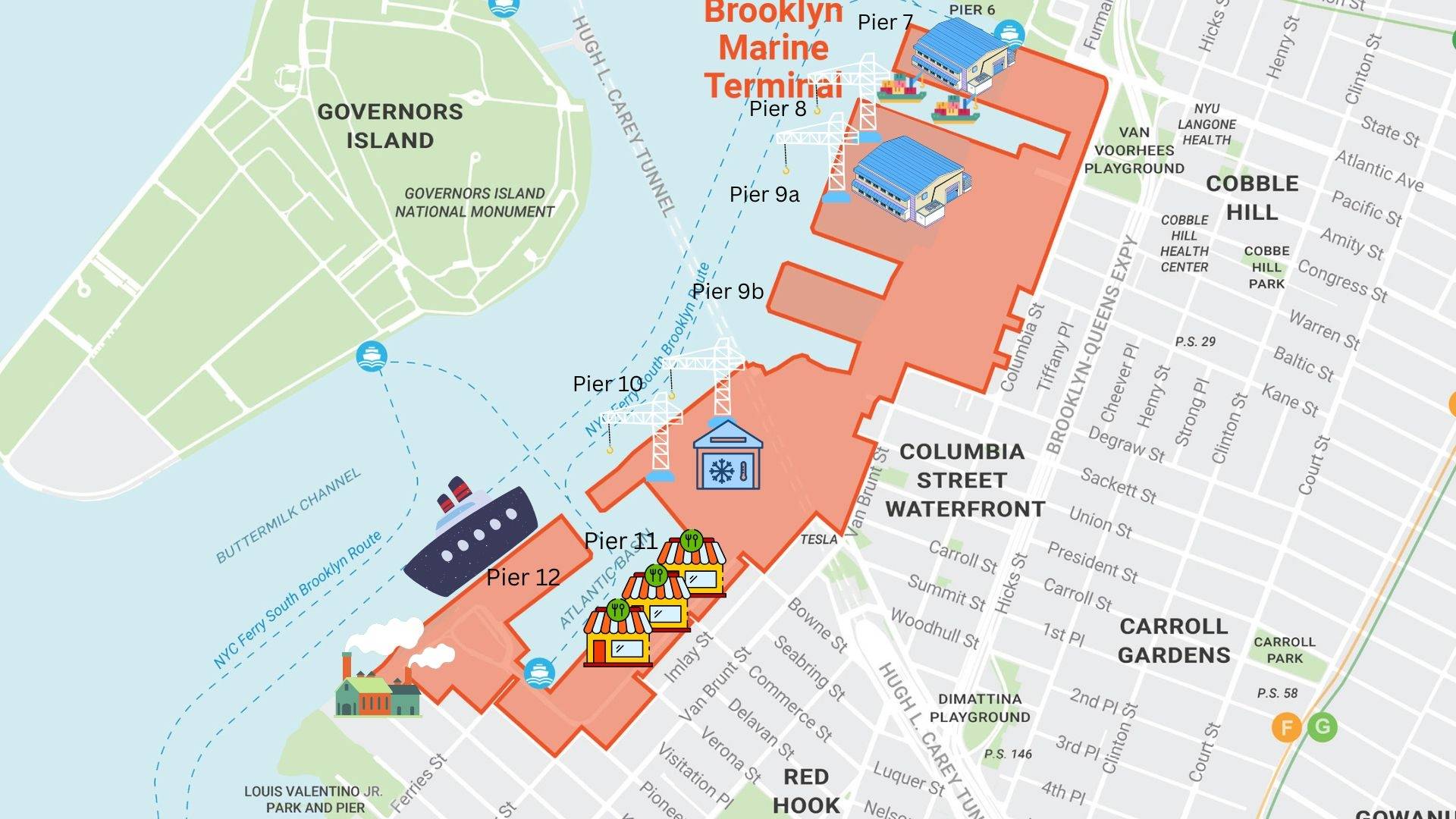It’s the evening of Dec. 18, 2024. The Brooklyn Marine Terminal task force is meeting for the fourth time, just before the winter holidays. Alexa Avilés, council member for District 38 and vice-chair of the task force, is late and arrives with about 30 minutes left of the two-hour meeting.
“I walked into chaos,” she said. “People immediately started beelining to me, and I was like,’ What is going on?’ ”
What was going on?
The task force members had just learned for the first time, at the tail end of the New York City Economic Development Corporation’s presentation, that thousands of housing units were necessary to fund the upgrades needed to make the Brooklyn Marine Terminal (BMT) into a modern maritime port. For months, what in press conferences, interviews, public workshops and task force meetings had been called a “potential non-port program,” something that would be “considered” and an “opportunity,” was now “needed” for the financial sustainability of the upgraded port. From seemingly out of nowhere, about 7,000-9,000 apartment units were necessary, of which 25% would be designated affordable at 60% of the Area Median Income (AMI) and the rest a mix of market-rate rentals and condos.
“I didn’t know that there was this unveiling. I was learning that as I walked into the space and people being very angry, feeling like this was the plan from day one. Seeing it in plain sight, I think, really angered people,” Avilés said.
The original unveiling
Last May, the Mayor and Governor Hochul announced a land transfer of the 122 acre Brooklyn Marine Terminal from the Port Authority to the City of New York. Under the ownership of the Port Authority most of the piers had fallen into disrepair (despite their responsibility to maintain it, per a 1979 agreement). Now, with new ownership, the plan was to turn the BMT into a modern maritime port and become a key node in the city’s Blue Highways initiative.
At that same press conference, it was also announced that the city would assemble a task force — comprised of elected officials, maritime experts, Red Hook businesses, real estate groups and community associations — to lead the work of coming up with recommendations for a master plan for what this new port should look like.
Since the EDC, which on behalf of the city is leading the Brooklyn Marine Terminal redevelopment, began creating a plan for the site, it has maintained that it’s committed to a robust public engagement process. Hochul and Rep. Dan Goldman (also the chair of the task force) echoed this sentiment during the May press conference, and on the project’s websitewhere a headline reads: “A Community-Driven Vision.” The EDC and its partners have also repeatedly claimed that the plan, at its core, is to build a modern port.
Empty talk
However, interviews with multiple task force members and a review of project-related documents (made available to the public by Brooklyn Community Board 6) poke holes in the city’s claims of commitment to community engagement and raise serious questions about how the planning process has been conducted—who actually has final say on the Vision for Brooklyn Marine Terminal and who the new marine terminal will ultimately serve.
Since May of last year, it has been publicly known that housing probably would be a part of the master plan in some shape or form. “We want to explore mixed-use development opportunities, including housing,” Governor Hochul told the crowd at the May 14 press conference, and at the same event, Deputy Mayor Maria Torres-Springer said that housing “will be considered.”
In the first couple of months of the planning process, housing was described as a consideration, an opportunity and a potential use for the non-maritime portion of the site, and it remained that way for much of the Fall. But by the end of November, a shift in tone began.
During the first public webinar, held on Aug. 14, 2024, DEC officials said that both affordable and market-rate housing would be considered, but at that point, the city didn’t know how much or what kind of housing would be included in the vision plan. Mikelle Adgate, senior vice president of government and community relations at EDC, explained that “there may be opportunities to cross-subsidize affordable housing and port infrastructure with market-rate development.” (This was the only time the potential for using market-rate development to cross-subsidize port infrastructure was mentioned to the community until January 2025.)
At the first public workshop, held at the end of September, one of the project goals was described as, “create new mixed-use residential development for the community.”
On Oct. 25, the EDC invited media to tour the parts of the BMT currently used for maritime purposes. EDC President Andrew Kimball led the tour and mentioned housing multiple times, saying that some of the non-maritime parts of the port could be utilized for various community uses.
“Those are the kinds of sites we need to be thinking about in this master plan process that can meet other community needs, whether it’s green space, housing,” Kimball said.
The next opportunity for the community to get an update came on Dec. 5, when the second public workshop was held. In the presentation given to attendees, staff from the architecture and design studio WXY — the company contracted to lead the public engagement process — mentioned housing multiple times. “The Vision for Brooklyn Marine Terminal is a generational opportunity to reimagine the site with modern maritime at its core and mixed-uses, including housing and community amenities,” read one of the presentation’s early slides. The city’s goal of creating new mixed-use residential development was reiterated, and “housing at multiple affordability levels” is also mentioned as an opportunity at the site.
Toward the end of the presentation, the community was, for the first time, introduced to how the marine terminal redevelopment would be financed. Maritime infrastructure costs (repairs of piers, construction of new piers, and bulkhead improvements), the slide said, were anticipated to be covered by project revenues (it was not specified further what those project revenues were). It was also noted that public realm infrastructure must be fully paid for by returns from housing and mixed-use spaces. The piers and the rest of the site used for maritime activities are not part of the public realm, as the public doesn’t have access to them.
The beginning of the reveal
Multiple community members who attended the second public workshop confirmed that there was no mention of how much the whole project would cost, nor that market rentals and condos would be the primary way to balance the books. But housing was now a part of the public conversations around financing the redevelopment; still not directly connected to port infrastructure upgrades or described as the primary source of revenue, but enough to mark the start of a dramatic turn that played out over the next month.
A similar shift was taking place inside the task force. In the November issue of the Red Hook Star-Revue (published at the beginning of the month), Jim Tampakis, owner of Marine Spares International and member of the task force, noted, “There’s really no talk about housing at this point. We’re talking more about how to create this water distribution network and upgrade the Red Hook Marine Terminal.”
Some members of the task force sensed an agenda.
“Andrew Kimball and certainly the mayor’s people kept shoehorning housing into the conversation.’ We’ve got to look at the port for all the uses, including housing,’ was always in that presentation,” Avilés said.
While the EDC does seem to want to make the site into a modern port, explained Carly Baker-Rice, executive director of the Red Hook Business Alliance, “there’s also tremendous pressure to put as many houses on the property as possible, and so their port plan reflects that.”
The initial presentations and pre-reads given to the task force described the potential role of housing in largely similar terms to how it had been described to the community at large: as one of many things to be explored through the planning process, as a general need in the community, and as a potential non-maritime program. Just as in the communication with the community, however, the narrative slowly drifted. To the task force, however, the EDC’s insistence on the need for residential development became more overt than to the community.
“All the facts presented are manufactured to lead you to the same place. Skepticism is well placed.” -Alexa Aviles
In the slide deck for the second task force meeting, it is noted that there is high demand for affordable housing and that mixing housing with other uses is becoming more accepted and “can provide resiliency in terms of a project’s financial and economic returns.” Later in the document, housing is called a “potential non-maritime program” and compatible with the overall project because it can “generate proceeds to cross-subsidize other uses and to be reinvested into the site.”
Still, the EDC never goes as far as revealing the role of housing in financing the project or saying aloud just how fundamental housing is to the city’s plans for the site.
Then, at the presentation at the third task force meeting, held on Nov. 20, the potential for apartment units to pay for infrastructure upgrades was touched on in conversations, according to the meeting summary. The idea generally received pushback, including from Baker-Rice, Cobble Hill Association President Amanda Sue Nichols, Assembly Member Marcela Mitaynes and staff from State Assembly Member Jo-Anne Simon’s office, who all noted that the community doesn’t want luxury developments. Simone Kanter, communications director for Rep. Dan Goldman, argued that market-rate housing shouldn’t be discounted as funding for the project. Based on the meeting summary and slide deck, no numbers were discussed regarding how much housing would be needed or what the redevelopment would cost.
It, therefore, still surprised many task force members on Dec. 18, when the EDC finally delivered its financial plan for the new port, seemingly going from cross-subsidies from housing as a possibility to a requirement.
The slides from the meeting quickly reached the public, sparking outrage among community members. Some also began asking whether the plan all along was to make the waterfront between Red Hook and Atlantic Avenue the latest playground for the city’s real estate developers, and upgrading the port was simply used as justification.

“All the facts presented are manufactured to lead you to the same place. The skepticism is well placed,” Avilés said.
The EDC maintains that its housing plans have been clear throughout the planning process.
“We’ve been super transparent,” Kimball said in a January interview with the Star-Revue. “The mayor and the governor, when they announced this historic deal, it was very clear in that press release exactly what we were hoping to achieve on this site, which was, at its core, a modern port, but also a mixed-use community with housing in particular, that not only met some of our key goals but also would create the kind of cross-subsidy needed to pay for the modern port that we needed.”
Not the case
Yet, the quasi-public agency’s own documents show that is not the case. In the May 14 press release, residential development is mentioned once — as a mixed-use opportunity to be explored — and cross-subsidies are not mentioned at all. And as in so many cases, the devil is in the details. In the pre-read provided to the task force ahead of its first meeting, housing is mentioned multiple times in similar, noncommittal terms as was the initial public presentations. But on the final page, buried in a section on land use approvals, in a paragraph about Howland Hook (the maritime facility the Port Authority received in the deal), the city and state’s plan for the Brooklyn Marine Terminal are laid out in black and white:
“The MOU [memorandum of understanding] right-sizes roles and responsibilities, facilitating planning and investment for both sites ultimately advancing common City and State goals of growing modern maritime ports and increasing housing production.”
However, on one of the information boards shown during the first public workshop, “growing modern maritime ports and increasing housing production” is described as “common policy goals.”
The discrepancy between information shared with the task force and the community, as well as the manner in which the EDC has relayed information throughout the public engagement process, has drawn criticism from task force members.
“I don’t think anybody’s felt like it’s been transparent. They aren’t responding to questions, concerns, corrections or requests for information. They do so very selectively, kind of picking off the ones that are easy and not controversial, but then never delivering on the other ones,” said Baker-Rice.
The EDC has mostly led the task force meetings. Several task force members have described how long and information-dense presentations are followed by brief opportunities for discussion.
“One of the biggest challenges of this process is that people really want to dig into and share and exchange information, and the way the meetings have been structured does not allow that,” Avilés said. “It feels both controlled and overwhelming at the same time. Offering you a boatload of information, never allowing for digestion and discussion, is a problem.”
The plan from an early stage was for residential development to cross-subsidize everything that needed to be done at the marine terminal. In a Jan. 26 letter to the task force leadership from
Andrew Kimball, the EDC president explains why it cannot base projections on possible future public funding and writes, “This is why we have assumed that a cross-subsidy is critical for the future of maritime at BMT.”
But the city doesn’t appear to have had a good idea of the financials of the project when it began the public engagement process. “We have been working as fast as we can with our consultants on pricing the cost of the infrastructure, and then figuring out what kind of housing density and what mixture of housing types, affordable versus market rate, rental versus condo sales, could pay for that port,” Kimball told the Star-Revue.
The uncertainty is also evident by the vast differences in cost estimates presented by the EDC at various points last year. In its application for a $164 million U.S. Department of Transportation Mega grant, submitted last spring, the city estimated that the total cost of the project — building a marginal pier (a pier that runs parallel to the shoreline) in place of 9A and 9B (which would be demolished) and rehabilitating Pier 10 — would be $273 million, according to DOT records. In December, when the EDC first presented its numbers to the task force and argued for the need for thousands of new apartment units, the price tag had ballooned: the cost for the new marginal pier alone was now nearly $1.2 billion, and it is not immediately apparent what changed.
Baker-Rice argued several questions about the project’s financial plan remain unanswered. “There are a lot of questions around feasibility. There are a lot of questions around funding. They continue to say that housing is the only way to fund this work,” she said. At the same time, not all sources of revenue appear to be included in the calculations. Both cold storage and the Blue Highway initiative could generate income, according to Baker-Rice.
“It’s a mismatched case right now, because they’re using the financials of the port to indicate what we can and cannot do for what price, but then they’re not including a big chunk of the revenue.
None of the numbers seem useful to work from, from a business perspective.”
With just over 2 months left before recommendations must be finalized (the deadline was initially the end of March, but at a Jan. 30 meeting it was pushed to the middle of April after the task force asked for more time), the EDC still doesn’t have clarity on the financial plan that largely will determine what the master plan will include.
Multiple reasons have been given for the aggressive time frame for coming up with a master plan, which began as a four-month planning process before it was extended to six months. Kimball has reiterated that the deteriorating piers could collapse any day, and a master plan is needed to deal with the problem. However, in the Mega grant application, the estimated project schedule indicates that just designing a new Pier 9 would take upward of two years, and construction wouldn’t start until 2028.
The Trump administration, not a fan of spending for the public good, has also been named as a reason for speedup. In a November task force meeting, Rep. Goldman began proceedings by discussing the need to proceed swiftly due to the incoming administration. After Trump’s brief freeze of federal spending on Jan. 27, State Senator Andrew Gounardes told the Star Revue, “As we just saw this week, the federal government has no problem turning the spigot off of funding to states. We really can’t afford to throw away a $164 million opportunity from the federal government, just given the realities of the Trump administration.”
The Mega grant has repeatedly been swung in defense from critics of the master plan deadline, which include Councilmember Avilés and Assembly Member Jo-Anne Simon. Supposedly, the grant will fall through without a master plan by the end of April. “What is likely to happen if we don’t have a fully baked plan for a new port that is funded is that we will lose the federal dollars,” Kimball said. “You don’t get a federal grant unless you have a master plan and you’re moving forward with assumptions about use of the port, transportation, all the environmental review that has to go into a federal grant.”
The situation is more complex, however. The transportation department may have provided project-specific deadlines for the city in documents not publicly available. Still, Kimball’s Jan. 26 memo to task force leaders and information about the Mega grant program on the DOT website indicate that the city is at least partially responsible for the deadline for the master plan. Kimball writes that recommendations for Brooklyn Marine Terminal must be in place in April for Mayor Adams to include the required local match of the Mega grant in his executive budget.
Council Member Avilés questioned the motives, saying, “I think EDC has its own interests that are aligned with the mayor, and they’re not working for the community. How we would try to ram a planning process into first four months and then six months, having a long track record of planning processes throughout the city that have taken upwards of two years, tells you everything you need to know.”
Others agreed that the public engagement phase is too short for the task force and the community to weigh in meaningfully. “The current pace is concerning. We need to take the time to get this right — not rush into decisions that could have long-term consequences for our working waterfront, our neighborhoods, and our city as a whole,” Assembly Member Simon wrote in a statement.
Ignoring the people
The shoehorning of housing into the master plan raises further concerns about the city’s supposed commitment to letting community feedback drive the vision for the Brooklyn Marine Terminal. Many community members have been vocal about the fact that they don’t want luxury development in their neighborhood. This has even been acknowledged by the EDC, which, in its presentations to the task force, has highlighted community comments like “NO HIGHRISES,” “No housing in an industrial flood zone,” and “Opportunities for homeownership for low/middle-income local residents.”
The task force, too, has largely pushed back on the idea of luxury condos and market-rate rentals and argued that housing must be affordable.
“This is public land, and doing luxury development on public land is irresponsible. It’s wrong, particularly when that’s not the housing we need in New York City,” Avilés told the Star-Revue.
Sen. Gounardes explained that he isn’t fundamentally opposed to housing, but there must be a discussion around it. “I think housing can and should be on the table. The question is housing for whom, the affordability and how much of it,” he said.
Avilés added that, although it is possible to leverage the private market for different things, “When you’re saying the private market is the only thing that’s going to save you and fund your parks, we are already starting from the wrong premise.”
The problem is that the EDC, to this point, hasn’t provided much in the way of alternative sources of revenue, appearing unwilling to consider taking more time to iron out what a diverse revenue stream could look like. “I don’t think anybody thinks that that is an appropriate sole means of funding such an enterprise, and it’s a question that we’ve been asking for a very long time, and we still don’t get very good answers,” Baker-Price said.
The task force now has five scenarios to consider, developed by EDC consultant Buro Happold, which are said to be based on feedback from the community, the task force and the advisory groups. Two are “as-of-right” scenarios, meaning that they project what would happen without a master plan. The other three all contain various levels of housing, ranging from about seven to twelve thousand units.
However, according to multiple task force members, the scenarios, including the one that is most likely to be up for a vote in April, have come together in spite of the opinions of the task force and the broader community.
WXY — at the behest of the EDC — has used models, games and site planning exercises to collect feedback, but it hasn’t been done in a forthright fashion, according to Baker-Rice. The site planning exercise introduced to the community at the third public workshop was missing key data and important constraints were not considered, potentially skewing the results.
Yet, data gathered from these sessions is being used to “inform” the scenarios the task force will soon vote on.
“They’re taking pictures and really demonstrating that they’re super involved and committed to this process, which they love to do,” said Baker-Rice. But, she added, “They’re using the outputs of that process to pretend like that’s where they’re getting their site plan recommendations from. None of those were put forward as recommendations from any of the groups — the public, advisory groups, or the task force — but they’re being used as such.”
In fact, the task force — whose role is to come up with and decide on the master plan — has not been given the opportunity to present any recommendations at all.
“Why do you keep insisting that this is part of this plan when you haven’t heard our vision, our interest, nor have we had a robust discussion around the opportunities and the challenges of the market, of the property, of all the other conditions?” Avilés asked.
Given the criticism of EDC’s process and how housing has been funneled into the master plan under the guise of community engagement, it is uncertain whether the final recommendations will survive a vote in the task force, which requires a two-thirds majority and “yes” votes from the chair and at least one vice-chair to advance decisions.

What happens then? Well, it’s not entirely clear. Since the beginning of the process, the EDC and others, including the task force’s chair, Rep. Goldman, and vice chair, Sen. Gounardes, have stated unequivocally that the task force has the final say. In August, the EDC said that the task force votes on the plan’s final recommendations. A month later, Mikelle Adgate with the EDC told the Star-Revue, “The really unique and interesting thing about that task force is that it will have the final sign-off on that vision plan.”
After the task force’s latest meeting, Sen. Gounardes seemingly confirmed that there is no plan if the task force doesn’t like the recommendations put forth by the city. “The city does not have final approval of this decision, the task force does,” he said.
If that happens, we’re stuck, according to Andrew Kimball. He put the onus on the task force, saying, “The task force may decide that the port is not as important as I think it is, or the mayor thinks it is, the Governor thinks it is, or the ILA [International Longshoremen’s Association) thinks it is.”
The EDC failsafe
But one of the first presentations given to the task force casts doubt over its authority. If the first proposal doesn’t get enough votes to pass, the project team — the city and its partners — will prepare alternative recommendations. If they don’t pass either, “alternative recommendations may be included in the Vision for BMT with accompanying explanation of the points of disagreement and acknowledgment that they are not supported by full consensus.” Whether or not this means that — should the second vote not gain a two-thirds majority — the recommendations laid out by the project team become the master plan with no further input from the task force, is not stated. But one elected official has her doubts.
“The commitment is that no plan moves forward unless they get an affirmative vote,” Avilés said.
“Now, what will EDC do? I don’t know, but that was the stipulation under the guise of the creation of the task force, that there would need to be an affirmative vote to move forward. Now, it doesn’t stop the city and the state from doing other things if they want to, ultimately, which is our problem with all advisory bodies.”
Author
-

I’m a New York-based journalist from Sweden. I write about the environment, how climate change impacts us humans, and how we are responding.
View all posts
I’m a New York-based journalist from Sweden. I write about the environment, how climate change impacts us humans, and how we are responding.












3 Comments
Excellent
As a Columbia Street Waterfront resident, I really appreciate Oscar’s in-depth analysis of how the EDC is circumventing the interests of the neighborhood and our elected officials, replacing them with what appears to be a power grab by our mayor to build 7,000, 9000, or, in the most recent option, over 12,000 units, 75% of them market-rate. Those of us who live here know that the current infrastructure can barely support the current population. Traffic on Columbia St often comes to a standstill, especially with the BQE lane shutdowns just north of us. I joined one of the “Lego blocks” planning sessions the EDC ran last month. When I raised concerns about transportation, services, schools, etc., etc., the EDC just responded that those were interesting points. I fear the task force (which does not include any community representatives from the Columbia Street Waterfront neighborhood) will be bulldozed, and the wonderful communities here and in Red Hook will suffer as luxury skyscrapers are built along the waterfront.
Excellent reporting of an under-covered issue in NYC. I have zero faith in the EDC and the mayor who has long been in the pocket of the real estate lobby to preserve the character of these neighborhoods. But, one can hope and I hope these high-rise towers are never built. I support the investment in the maritime industry.